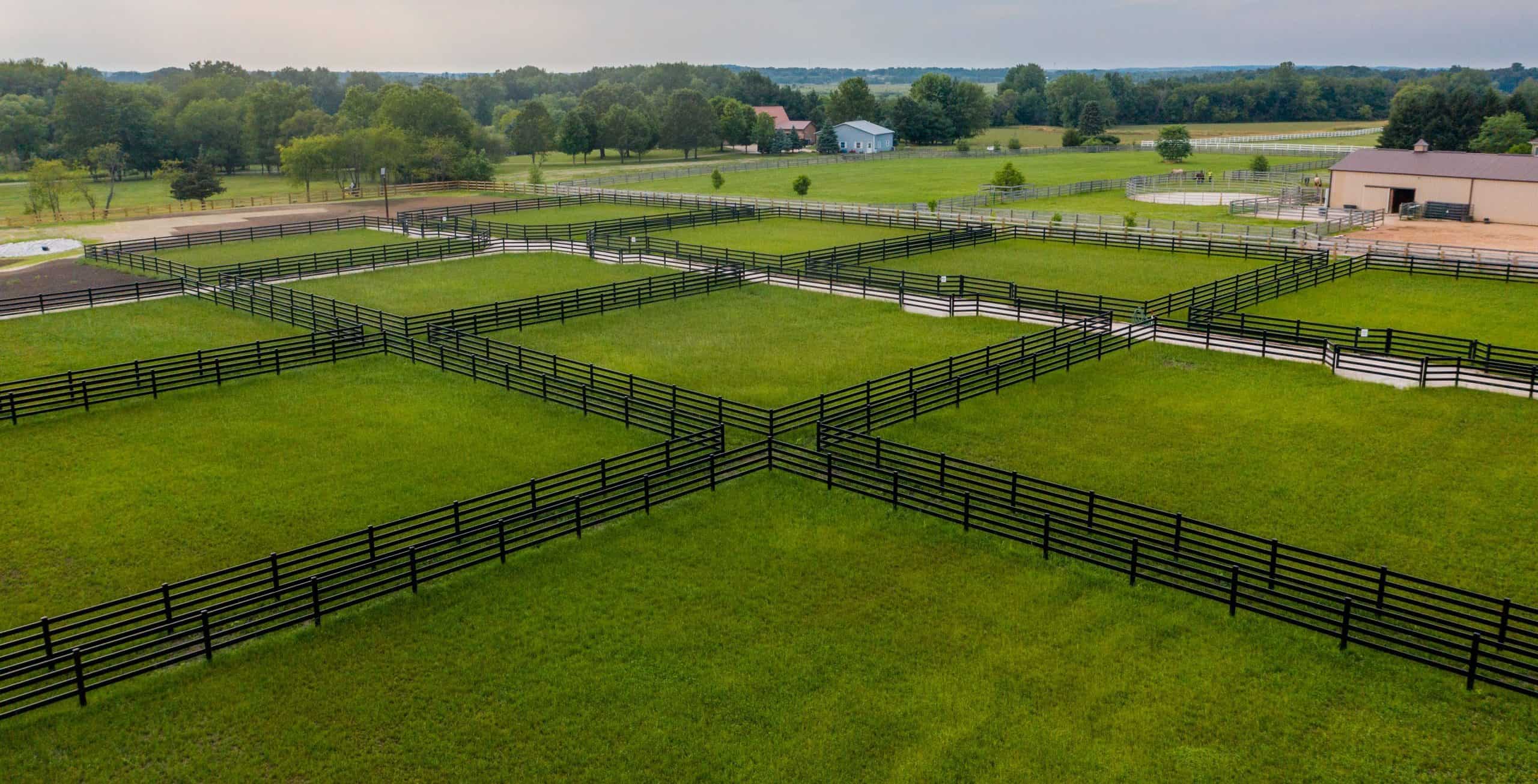When it comes to fencing your property, there’s the price you pay at installation and then there’s the true cost that reveals itself over time. We’ve seen it too many times: ranch owners who thought they saved money upfront, only to find themselves replacing entire sections just a few years later.
The math isn’t complicated. A “cheap” fence that needs replacement every 5-7 years will cost you far more than a quality fence that stands strong for decades. But longevity isn’t just about saving money. It’s about the peace of mind that comes from knowing your animals are secure, your property is protected, and you’re not facing another major project just when your operation needs your attention elsewhere.
What makes a fence truly last isn’t always what you might expect. Marketing brochures talk about warranties and features, but out here in the real world (where snow piles up, winds howl, and horses test boundaries daily) the truth about fence longevity becomes more clear.
Below, we’re cutting through the sales talk to give you straight facts about what materials actually stand the test of time. We’ll examine wood, vinyl, wire options, and steel systems, looking at not just how long they last but why they fail. Because understanding the why helps you make better decisions for your specific situation.
Fence Lifespan: Setting Realistic Expectations
When manufacturers talk about fence lifespans, they’re typically referring to ideal conditions: moderate climate, perfect installation, and regular maintenance. The reality on most ranches is quite different.
Real-World Material Lifespans
- Wood fencing: 7-15 years depending on species and treatment. Even premium cedar or pressure-treated pine begins showing significant deterioration around the decade mark in most climates. Posts in contact with soil often fail first.
- Vinyl fence systems: Manufacturers claim 20-30 years, but we regularly see significant deterioration by year 15 in harsher environments. Brittleness increases dramatically after about 10 years of UV exposure.
- Metal wire fences: Generally provide 15-20 years of service before rust and tension issues create security concerns. The framework might stand longer, but the functional lifespan ends much sooner.
- Aluminum fencing: Can last 20-30 years but often suffers from structural weakness that makes it unsuitable for containing livestock or horses in the first place.
- Steel board fencing: When properly manufactured and installed, consistently delivers 30+ years of reliable service, with many installations still performing perfectly after four decades.
Factors That Accelerate Deterioration
A few elements dramatically reduce fence longevity (regardless of material):
- Soil conditions matter enormously—acidic soils eat through metal and concrete, while expansive clay soils put tremendous pressure on posts during freeze-thaw cycles.
- Weather extremes take years off expected lifespans. Areas with heavy snowfall, high winds, or dramatic temperature swings see fence failures much earlier than temperate regions.
- Animal pressure creates consistent stress that manufacturers rarely account for in their lifespan claims. A fence containing energetic horses experiences forces that backyard privacy fencing never encounters.
Ultimately, manufacturer warranties often reflect best-case scenarios, not the demanding conditions of a working ranch. When planning your fencing investment, add a healthy dose of real-world perspective to whatever the brochure promises.
The Longest Lasting Fence in 2025
If you’re looking to invest in fencing that truly goes the distance, you need to know what’s actually performing in the field, not just what looks good in a catalog. Here’s our honest evaluation of the longest-lasting fence options available today, ranked by real-world durability.
| Fence Material | Expected Lifespan | Maintenance Level | Best For | Drawbacks |
| Steel Board | 30-50+ years | Minimal | Horses, livestock, perimeters | Higher initial cost |
| Aluminum | 20-30 years | Very low | Decorative, pools, gardens | Limited strength for animals |
| Vinyl | 15-30 years | Low | Residential, light livestock | Brittleness over time, UV damage |
| Chain Link | 15-25 years | Moderate | Security, dogs, general containment | Appearance, climbing potential |
| Wood (Cedar) | 7-15 years | High | Traditional aesthetics, privacy | Rot, insect damage, warping |
1. Steel Board Fence
Steel board fencing stands at the top of the durability pyramid for good reason. Today’s advanced steel fencing systems combine galvanized steel with protective coatings that resist corrosion for decades. Unlike other materials, steel maintains its structural integrity through extreme weather, animal pressure, and UV exposure.
The Buckley Steel Board system is engineered with an optimal thickness that balances flexibility with strength, preventing the brittleness issues that plague other materials as they age. For ranchers and horse owners tired of replacement cycles, steel delivers a true “install it and forget it” solution that often outlasts the original owner.
2. Aluminum Fence
Aluminum fencing earns second place for longevity thanks to its natural corrosion resistance. It oxidizes on the surface only, creating a protective layer that prevents deeper deterioration. Modern aluminum fences typically feature powder-coating that further extends their lifespan.
The downside is strength—aluminum simply doesn’t have the structural integrity to contain large livestock or energetic horses safely. It’s great in decorative applications, property boundaries, and pool enclosures. For the right application, an aluminum fence installed today could easily still be standing strong in 2050.
3. Vinyl Fence
Vinyl fencing (PVC) offers respectable longevity when quality materials are used. The better systems incorporate UV inhibitors and impact modifiers that help maintain flexibility over time. However, even the best vinyl eventually succumbs to sun damage, becoming increasingly brittle after 10-15 years of exposure.
Temperature fluctuations also take a toll, with expansion and contraction gradually weakening connection points. Vinyl performs best in moderate climates without extreme temperature swings and works well for residential properties or containing smaller, less-challenging animals.
4. Chain Link Fence
Chain link’s longevity comes from its simplicity. Fewer components mean fewer potential failure points. Today’s chain link fences benefit from improved galvanization processes that significantly extend their rust resistance.
Framework strength is key to longevity—look for schedule 40 pipe for maximum durability. The mesh typically shows signs of rust before the framework fails, particularly at tension points. While not the most attractive option, chain link reliably provides security and containment for 15-25 years depending on wire gauge and coating quality.
However, it’s not a suitable option for containing horses or livestock.
5. Wood Fence (Cedar)
Cedar represents the best of traditional wood fencing options, naturally resistant to insects and decay compared to other species. However, even premium cedar begins to show major deterioration after 10-15 years in most climates. The ground-contact points inevitably succumb to moisture intrusion, regardless of treatment methods.
While wood delivers unmatched traditional aesthetics, the maintenance requirements are substantial—regular staining or sealing is necessary to approach the upper end of its potential lifespan. For those committed to maintenance, cedar can provide 12-15 years of service before major components need replacement.
Construction Factors That Impact Fence Lifespan
Even the highest quality fencing materials can fail prematurely if installation corners are cut. We’ve identified several construction factors that dramatically affect how long your fence will stand strong, regardless of material choice. These elements often make the difference between a fence that lasts decades and one that needs replacement.
- Post foundation depth – Shallow post holes are the number one cause of premature fence failure. Posts should extend below the frost line in your region, typically 30-48 inches deep in northern climates. Each foot of depth you skimp on can cut years off fence life.
- Concrete quality and coverage – Posts need full concrete encasement, not just a partial pour. Using proper concrete mix ratios (not too wet) and allowing complete curing before adding tension creates foundations that won’t crack under pressure.
- Post spacing – Stretching the distance between posts beyond manufacturer recommendations saves money upfront but creates excessive strain during wind events or when animals test the fence. Proper spacing distributes force evenly throughout the system.
- Hardware quality – Galvanized or stainless steel fasteners cost more but prevent the premature rusting that leads to connection failures. Never use indoor-rated hardware on exterior fencing.
- Proper tensioning – Over-tensioning wire or boards creates constant stress that accelerates failure. Under-tensioning leads to movement that works fasteners loose over time. Each material has an optimal tension point that maximizes longevity.
- Terrain adaptation – Following the land without accounting for water flow patterns invites erosion that undermines posts. Proper grading and water diversion techniques protect your fence’s foundation.
- Expansion allowance – Rigid installation without accommodation for temperature-related expansion and contraction creates points of failure, especially in vinyl and metal fencing. Proper spacing at connection points prevents this stress.
- Protective flashing – Where different materials meet (especially wood and metal), protective barriers prevent moisture traps that accelerate deterioration. This simple addition can add years to post life.
- Termination bracing – Corners and ends experience the greatest force in any fence system. Proper H-braces or diagonal supports at these points prevent the domino effect of sequential post failures.
- Ground contact protection – Using concrete aprons, gravel drainage beds, or protective sleeves around ground-contact points dramatically extends post life by minimizing soil-related deterioration.
Do It Once, Do It Right, Do It with Buckley
The fence that’s still standing decades from now will be the one that combined quality materials with proper installation and realistic expectations for your specific conditions.
We’ve seen too many ranch owners learn the hard way that cutting corners on fencing leads to an endless cycle of repairs and replacements. That approach doesn’t just drain your wallet—it steals time you could be spending on what matters most: your animals, your land, and your operation.
At Buckley Fence, we believe in building things once and building them right. Our steel board fencing systems are engineered specifically to outlast the alternatives by decades, not just years. When you factor in the lifetime cost, including maintenance and replacement cycles, the value becomes obvious.
Your property deserves protection that stands the test of time. Your animals deserve containment you can trust completely. And you deserve the peace of mind that comes from knowing you won’t be replacing that fence again in a few years.
Ready to break the cycle of fence replacement? Let’s talk about creating a fencing solution for your property that’s truly built to last.



